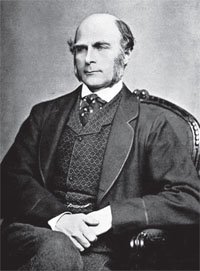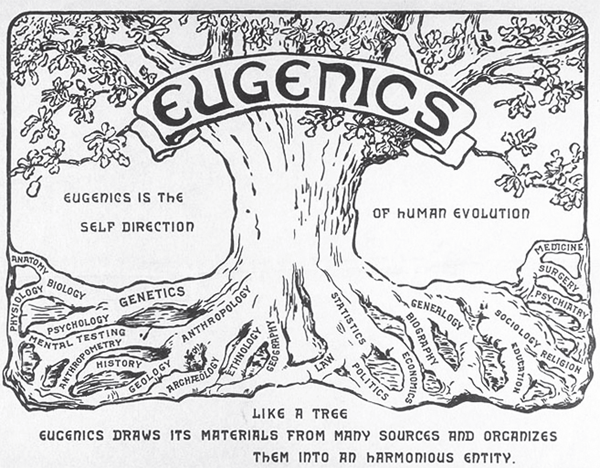What about Eugenics and Planned Parenthood?
by Dr. Georgia Purdom on June 2, 2014Life is precious—no matter how short or how impaired that life may be.
In 1915 a baby boy was born to Anna Bollinger. The baby had obvious deformities, and medical doctor Harry Haiselden decided the baby was not worth saving.1 The baby was denied treatment and died. The story became national news and the cruelty of eugenic practices became public knowledge.
The year 1915 seems far removed from our modern times, but the concept of eugenics is alive and well. In 2005, two doctors from the Netherlands published “The Groningen Protocol—Euthanasia in Severely Ill Newborns.”2 This protocol was published to help doctors decide whether or not a newborn should be actively killed based on the newborn’s disease and perceived quality of life.3
In this chapter we will explore historical and modern perspectives of eugenics, how Planned Parenthood has played a role in furthering the cause of eugenics in the past and present, and what the proper biblical perspective on these issues should be.
What Is Eugenics?
The term eugenics was first coined in 1883 by Francis Galton, father of eugenics and cousin of Charles Darwin. The term comes from the Greek roots eu (good) and genics (in birth) to communicate the idea of being well-born.
The ultimate goal of eugenics was to create a superior race of humans.4 Many adherents believed in evolution by natural selection, but that natural selection was moving too slowly in favoring the best and eliminating the worst.5 They also believed that charity in the form of taking care of the poor and sick was prohibiting natural selection from working properly and thus the need to intervene with artificial selection.6
Artificial selection was accomplished through two types of eugenics—positive and negative. Positive eugenics focused on increasing the “fit” through promoting marriages among the well-born and promoting those fit couples to have multiple children. Negative eugenics focused on decreasing the number of the “unfit” through prohibiting birth (birth control and sterilization) and segregation (e.g., institutionalization of the unfit, marriage restriction laws, and immigration restriction).
History of Eugenics
Although many people associate eugenics with the late 1800s and early 1900s, it is an ancient idea that was in practice long before it was called eugenics. The Law of the Twelve Tables (449 B.C.), which served as the foundation of Roman Law, states “Cito necatus insignis ad deformitatem puer esto,” which means, “An obviously deformed child must be put to death.”7 Both Plato and Aristotle supported this practice8 and it was not uncommon for infants to be exposed or left outside the home for a period of time to determine if they were fit enough to survive. The Romans wanted only the most fit for their future warriors.
Francis Galton, upon reading his cousin Charles’s book Origin of Species, 9 decided to apply the mechanisms of natural and artificial selection to man. He stated, “Could not the undesirables be got rid of and the desirables multiplied?”10 Galton promoted the ideas that human intelligence and other hard-to-measure traits such as behaviors were greatly influenced by heredity (not the environment, which was the popular mindset of the day).11He advocated for a program of positive eugenics. His book Hereditary Genius (1869) was well liked by Charles12 and had a great influence on the ideas presented in his bookDescent of Man (1871).13
In the early 1900s the eugenics movement became well established in the United States. The movement was well-funded by men like Carnegie, Rockefeller, and Kellogg. Eugenic societies, conferences, research institutions, and journals gave a façade of real science to the study of eugenics. This was further promoted by eugenic departments and courses at the university level.
The American eugenics movement focused heavily on negative eugenics.14 Ten classes of social misfits were determined upon which programs of negative eugenics were applied.
All of these traits were thought to be inheritable.16 Ten percent of the American population was thought to fit into these broad, ill-defined categories (sometimes known as the “submerged tenth”).17 Many of those people were forcibly institutionalized in asylums for the “feebleminded and epileptic.” Although not stated in the list, those of “races” other than the Caucasian “race” would also, by the mere fact of ethnic background, be placed into one or more of these categories. Unfortunately, the eugenics movement in the United States heavily influenced Hitler and his scientists and, in return, many eugenicists and eugenic publications supported the horrifying practices of Hitler’s Nazi regime. Negative eugenic practices were even sanctioned by the American government.
Forced Sterilization
In 1907, Indiana enacted the first forced sterilization law. The law would be applied to “mentally impaired patients, poorhouse residents, and prisoners.”18 Over 30 states enacted sterilization laws, and between 60,000 and 70,000 people were forcibly sterilized between 1900 and 1970.19 Most forced sterilizations were performed after 1927. In 1927 the Supreme Court ruled in favor of the forced sterilization of Carrie Buck20 (in Buck v. Bell) with justice Oliver Wendell Holmes stating, “It is better for all the world, if instead of waiting to execute degenerate offspring for crime . . . society can prevent those who are manifestly unfit from continuing their kind. . . . Three generations of imbeciles are enough.”21
Immigration Restriction
The Immigration Act of 1924 set quotas on the number of people allowed into the United States from other countries. Lawmakers were heavily influenced by “scientific data” presented to them by high-ranking members of the eugenics movement.22
Marriage Restriction Laws
These laws (which varied by state) were designed to keep the Caucasian “race” pure. The laws prohibited “mixed race” marriages (i.e., Negro and Caucasian) but also marriages with those considered defective (e.g., blind).
What Was the Christian Response to Eugenics?
The Christian response to eugenics was mixed. The Christian apologist G.K. Chesterton condemned eugenics in his 1922 book Eugenics and Other Evils. He saw how eugenics was being used in Germany to support Nazi ideals.23
However, some pastors used their pulpits to promote eugenics. The American Eugenics Society sponsored a sermon contest in 1926. Of the five sermons I read online, all were filled with popular rhetoric from the eugenics movement with little scriptural support given for eugenics. The pastors seemed to have accepted the “science” of eugenics without analyzing it in light of the Bible.24 This is very similar to the modern situation in which many Christian pastors accept the “science” of evolution, promote the idea in their churches, and don’t analyze the conflicts between evolution and Scripture.
History of Planned Parenthood and Its Relationship to Eugenics
The name most commonly associated with Planned Parenthood is that of its founder Margaret Sanger. Margaret was born in 1879, the 6th of 11 children in a poor family, in New York.25 She was initially quite committed to the Catholic faith but eventually became very cynical in part due to the influence of her “free thinking” father.26 Margaret married into money and eventually became an active member of the Socialist Party. She was attracted to the party’s fight for “women’s suffrage, sexual liberation, feminism, and birth control.”27 Sanger also became a fan of the concepts promoted by Thomas Malthus (who also heavily influenced Charles Darwin in the development of the concept of evolution by natural selection). Malthus was concerned that the human population was growing too rapidly (especially the poor, diseased, and racially inferior) and would outgrow natural resources. The solution proposed by his followers, like Sanger, was to decrease and eliminate the “inferior” population through birth control (including sterilization and abortion).28 Sanger stated, “The most merciful thing a large family can do to one of its infant members is to kill it.”29
Sanger became one of the foremost champions of birth control and not just for the benign reason of helping poor women who could not afford large families, but also for “the liberation of sexual desire and the new science of eugenics.”30 In 1921 she organized the American Birth Control League. In 1922 she published the book The Pivot of Civilizationwhich “unashamedly called for the elimination of ‘human weeds,’ for the cessation of charity, for the segregation of ‘morons, misfits, and the maladjusted’ and for the sterilization of ‘genetically inferior races.’ ”31 Sanger stated:
Her magazine, The Birth Control Review, contained many articles authored by leading eugenicists of her day. Sanger openly endorsed the concepts and methods of race purification carried out by the Nazis.33 Sanger believed sex was an evolutionary force that should not be prohibited because of its ability to create genius.34 In 1942, the American Birth Control League became the Planned Parenthood Federation of America (PPFA).
Modern Perspectives on Eugenics and Planned Parenthood
Eugenics became associated with the horrors of the Nazi regime in the 1940s and so its popularity in the public arena began to fade. In addition, much of the so-called “science” of eugenics was shown to be false by increased knowledge in the field of genetics. It became almost laughable to think that the eugenic-defined trait of “sense of humor” (no pun intended!) could be associated with a particular gene and/or somehow quantified.
However, eugenic concepts and the eugenic ideals of PPFA didn’t die. Edwin Black states, “While human genetics was becoming established in America, eugenics did not die out. It became quiet and careful.”35 The eugenic agenda today is not different in principle or goal but only in name and methods. Eugenicist Frederick Osborn in 1965 stated, “The term medical genetics has taken the place of the term negative eugenics.”36 Genetic databases filled with individual genetic identities could now generate precise family genetic profiles as opposed to the subjective determination of non-measurable traits by self or other family members stored on millions of index cards that filled eugenic institutions in the early 20th century. In recent years, many feared the adverse use of genetic identities and profiles when applying for jobs and insurance.37
James Watson, co-discoverer of the structure of DNA, stated in 2003, “If you are really stupid, I would call that a disease. The lower 10 percent who really have difficulty, even in elementary school, what’s the cause of it? A lot of people would like to say, ‘Well, poverty, things like that,’ It probably isn’t. So I’d like to get rid of that, to help lower the 10 percent.”38The idea of the “submerged tenth” is still alive and well in the 21st century.
Preimplantation genetic diagnosis (PGD) allows parents who have embryos created for use in in vitro fertilization (IVF) to check for genetic disorders and chromosomal abnormalities before the embryos are implanted. The “defective” embryos are destroyed. PGD is also being used for sex selection (only babies of the desired sex are used for IVF), disability selection (e.g., deafness), and predisposition or late-onset disease selection (i.e., predispositions to cancer and late-onset diseases like Alzheimer’s).39 Embryos are destroyed if they are not the desired sex, will have a disability, or may have cancer or disease later in life. PPFA endorses prenatal diagnosis procedures and genetic counseling.40 Eugenic concepts of prohibiting the birth of the “unfits” is still popular in the 21st century.
Planned Parenthood still endorses many eugenic ideas. This should not be surprising as the PPFA website “History and Successes” page clearly states, “Margaret Sanger, the founder of Planned Parenthood, is one of the movement’s great heroes. Sanger’s early efforts remain the hallmark of Planned Parenthood’s mission. . . .”41 Sanger’s efforts advocated sterilization, abortion, and infanticide of “defectives” in the name of eugenics. Further indicative of the promotion of eugenics, PPFA endorses abortion of deformed babies:
Thus, those infants who are “gravely deformed” should have been permitted to be eliminated according to PPFA. According to the American Life League, in 2006 PPFA was directly responsible (through its clinics) for 289,750 abortions.43 Thus, PPFA was responsible for almost 25 percent of the abortions estimated to have occurred in the U.S. in 2006.44
PPFA also still advocates for sexual liberation by encouraging the concept that sex and sexual desire is part of a normal, healthy lifestyle.45 These concepts are in line with Sanger’s view of sex, which she wrote about in a letter to her 16-year-old granddaughter: “Kissing, petting, and even intercourse are alright as long as they are sincere.”46 Alan Guttmacher, former president of PPFA stated, “We are merely walking down the path that Mrs. Sanger carved out for us.”47 How true!
Biblical Perspectives on Eugenics and Planned Parenthood
When we start with the truth of God’s Word, we see that eugenics and the ideas promoted by Planned Parenthood do not align with the Bible.
The Bible Shows That God Considers All People Equal
God doesn’t care whether people have dark brown skin or light brown skin, whether they are deaf or have perfect hearing — God does not show partiality.
The Bible Shows That Life Is Precious to God
God created each of us individually and we are His image-bearers on earth. He loved us so much that He sent His Son Jesus to die for us so that we might have eternal life.
The Bible Shows the Importance of Caring for the Needy
God commands us to care for people no matter what their affliction.
Conclusion
My friends John and Tina were told after 19 years of marriage that they were going to have a baby.48 They were very excited and then the news came that the baby might have a chromosomal abnormality. Tina shared with me:
John said:
Life is precious—no matter how short or how impaired that life may be. Contrary to the ideas supported by eugenics and Planned Parenthood, all human life has value because it comes from the Life Giver.



No comments:
Post a Comment
Note: Only a member of this blog may post a comment.